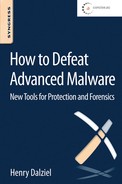Book Description
How to Defeat Advanced Malware is a concise introduction to the concept of micro-virtualization. The book provides current facts and figures that prove detection- based security products have become ineffective. A simple strategy is then presented that both leverages the opportunities presented by Bring Your Own Device (BYOD) and protects enterprise end users against advanced malware. The book concludes with case studies demonstrating how hardware- isolated micro-VMs are helping Fortune 500 financial service providers defeat advanced malware.
This book is primarily designed for infosec professionals, consultants, network administrators, CIO’s, CTO’s, CISO’s and senior executives who work within the financial industry and are responsible for their company’s endpoint protection.
How to Defeat Advanced Malware: New Tools for Protection and Forensics is the first book to compare and contrast current endpoint security products, while making a case for encouraging and facilitating the growth of BYOD and social media by adopting micro-virtualization.
- Learn the basics of protecting your company's online-accessible assets
- Discover strategies that take advantage of micro-virtualization and BYOD
- Become adept at comparing and utilizing different endpoint security products and strategies
Table of Contents
- Cover
- Title page
- Table of Contents
- Copyright
- Author Biography
- Contributing Editor Biography
- Chapter 1: A Primer on Detection for Security
- Chapter 2: 2014 Endpoint Exploitation Trends
- Chapter 3: The Proposed Solution
- Chapter 4: Protection’s Weak Link
- Chapter 5: Micro-Virtualization
- Abstract
- 5.1. Related work
- 5.2. A practical example
- 5.3. Hardware-enforced task isolation
- 5.4. Hardware virtualization technology
- 5.5. Micro-virtualization at work
- 5.6. The microvisor
- 5.7. Memory and CPU isolation
- 5.8. Virtualized file system (VFS)
- 5.9. Virtualized IP networking – the mobile SDN
- 5.10. Virtualized desktop services
- 5.11. Creation and management of micro-VMs
- 5.12. Reducing the attack surface
- Chapter 6: Advanced Forensics and Analysis
